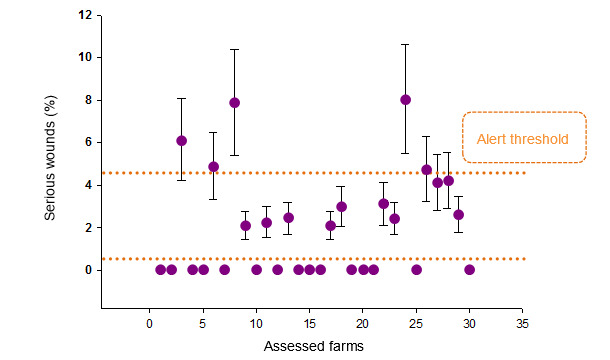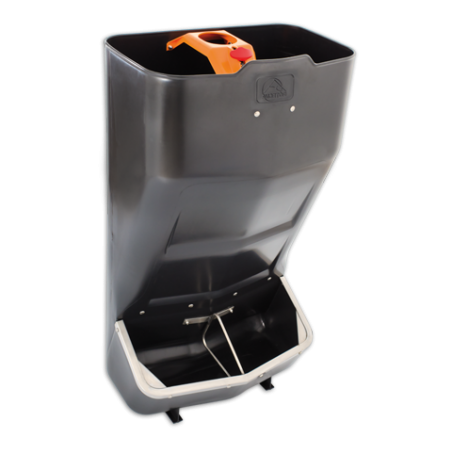The Welfare Quality® (WQ) protocols provide us with a tool for assessing the animal welfare in an unbiased and standardized way with valid, repeatable and practical parameters. It can be considered as a reference method for the comprehensive evaluation of the animal welfare at a farm and abattoir level using parameters based on the animal. The WQ protocols are based on 12 animal welfare criteria that are regrouped in 4 basic principles (feeding, housing, health and appropriate behaviour). In the case of swine, three protocols have been developed: the first one for sows and piglets, the second one for fattening pigs, and the third one for the pigs at the abattoir.
The WQ protocol for fattening pigs has been tested in a wide range of intensive and extensive farms. By means of the standardized implementation of the welfare assessment system we have obtained a series of prevalences that are comparable between different husbandry systems. As an example, we can offer a summary of the comparison of the prevalences obtained in the conventional pig production system on slats (in Spain and France), and the rearing system on straw (in France) (Table 1). According to the results obtained, the pigs housed on straw have fewer bursitis (inflammations of the joints), and have a lower frequency of aggressions and more exploratory behaviours. On the other hand, these animals show more hygiene (faeces on the body surface) and body condition problems than the ones housed on the conventional system. There comparisons can be considered between production systems, countries, regions, or even at a level of a population of farms of interest. More specifically, for the intensive production system of conventional pigs on slats, risk thresholds have been established comparing Spanish farms, and this allows us to identify the most challenging farms from an animal welfare point of view. So, for instance, we can detect five more problematic farms with respect to the prevalence of pigs with wounds on the body surface (Figure 1).

Table 1. Summary of the average prevalences and the standard errors obtained by means of the implementation of the Welfare Quality® protocol in conventional pig farms rearing the animals on slats or straw.
| Welfare principles | Measurements based on the animal | Intensive system on slats | Intensive system on straw |
| Good feeding | Body condition | 0.4 ± 0.14b | 0.9 ± 0.31a |
| Moderate bursitis | 43.5 ± 1.01a |
3.8 ± 0.62b |
|
| Severe bursitis | 7.8 ± 0.53a | 0.2 ± 0.13b | |
| Faeces on the 25% - 50% of the body surface | 23.5 ± 1.06b | 30.8 ± 2.62a | |
| Faeces in > 50% of the body surface | 5.3 ± 0.60b | 15.6 ± 2.65a | |
| Huddled animals | 3.5 ± 0.60 | 1.9 ± 0.84 | |
| Animals shivering | 0.0 ± 0.00 | 0.1 ± 0.11 | |
| Animals panting | 0.2 ± 0.07 | 0.7 ± 0.27 | |
| Good health | Severe wounds on the body surface | 2.5 ± 0.35 | 1.4 ± 0.40 |
| Tail biting | 1.1 ± 0.27 | 1.4 ± 1.26 | |
| Lameness | 1.2 ± 0.17 | 2.3 ± 0.31 | |
| Discoloration/Inflammation of the skin on < 10% of the body surface | 1.6 ± 0.17 | 0.5 ± 0.19 | |
| Discoloration/Inflammation of the skin on > 10% of the body surface | 2.1 ± 0.28 | 0.1 ± 0.10 | |
| Diarrhoea (at a group level) | 9.0 ± 0.2 | 15.9 ± 0.4 | |
| Breathing difficulties | 0.2 ± 0.06 | 0.2 ± 0.13 | |
| Rectal prolapse | 0.0 ± 0.00 | 0.0 ± 0.00 | |
| Hernia | 0.1 ± 0.04 | 0.2 ± 0.13 | |
| Appropriate behaviour | Aggressions | 4.5 ± 0.28a | 2.9 ± 0.53a |
| Exploratory behaviour | 35.0 ± 1.07b | 39.3 ± 1.95a | |
| Panic response in the presence of an observer | 24.4 ± 2.00b | 37.8 ± 2.00a |
Figure 1. Prevalences (and standard deviation) of pigs with serious injuries for each farm assessed. The established risk thresholds are shown in orange colour.

The protocol is a very useful diagnostic tool for having a comprehensive view of a farm on a certain moment. Once the critical points on each farm have been identified, we can establish treatment and prevention strategies. Then, the protocol can be used continuously throughout time to monitor the progress of the state of a farm and to evaluate the impact of a treatment (or preventative) measure. Having as a baseline the WQ protocol, we expect, in the future, to develop welfare monitoring protocols adapted to the needs of each company or individual.
Apart from its use in an intervention and monitoring program, the WQ protocol is being widely used in research under commercial conditions. According to the goal of the study, the protocol is applied as a whole or some of its measures are used. So, for instance, the effect of a new hosing or a change in the handling is measured through indicators based on the animal. The use of standardized measurements allows us to develop risk factors studies that can be easily compared with the results obtained in other countries.
So, for example, in a study carried out in different production systems, the incidence rate of tail biting was associated with the intensive production systems. Although the animals reared in an extensive production system did not have their tail docked, no cases of tail biting were detected in any of these animals. The prevalence of tail biting in the 3 studied intensive production systems was significantly similar: conventional intensive system (1.1%); on straw (1.4%); intensively reared Iberian pigs (0.2%). In the conventional intensive system, we detected several possible risk factors: the pigs fed with a restricted (with respect to time) liquid feeding system showed a higher risk of tail biting (Odds Ratio 5 IC 1.3-10) in comparison with the pigs fed with dry-wet feeders. The ambient temperature was also detected as a possible causative factor. The lowest temperatures (15-20ºC) were associated to a higher tail biting incidence, being this probably due to a higher activity of the animals. Finally, the tail biting risk increases significantly in those pigs halfway through the fattening period (OR 5 IC 1.4-17) in comparison with the initial and the final stages of the fattening period.
In several European countries, we can see a growing interest of individuals on certification schemes. The certification schemes intend to focus toward new market niches, going beyond the requirements established by the current legislation. In the case of animal welfare, these schemes confer an added value to a certain animal welfare standard. The WQ protocol provides a standardized, unambiguous, clear and detailed tool that fulfils the requirements in order to be included in a certification scheme.
Finally, it is possible that in a near future, the European legislation prioritizes the measurements based on the direct observation of the animal with respect to the environmental measurements. The WQ protocol can be a source of measurements that are valid, repeatable and easy to implement by the authorities.





